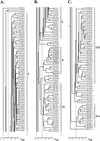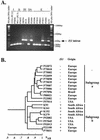Ca3 fingerprinting of Candida albicans bloodstream isolates from the United States, Canada, South America, and Europe reveals a European clade
- PMID: 12149321
- PMCID: PMC120649
- DOI: 10.1128/JCM.40.8.2729-2740.2002
Ca3 fingerprinting of Candida albicans bloodstream isolates from the United States, Canada, South America, and Europe reveals a European clade
Abstract
It was previously demonstrated by a cluster analysis that 26 unrelated U.S. isolates of Candida albicans separated into three distinct groups (groups I, II, and III) while South African isolates separated into four distinct groups (groups I, II, III, and SA). To verify the absence or underrepresentation of SA isolates in North America, and to identify which groups are represented in Europe and South America, collections of bloodstream isolates from each geographical locale were analyzed by cluster analyses based on genetic fingerprinting with the Ca3 probe. The results verify that North America is almost devoid of SA isolates (2%). However, the results reveal a new clade, designated group E, relatively specific to Europe. While 26% of a European collection of 46 isolates was composed of group E isolates, only 2% of the 164 North American isolates, 5% of 22 South American isolates, and 1% of 361 South African isolates were composed of group E isolates. The North American collection proved to be the least-diverse collection in regard to group representation. In a comparison of collections from the Northeast, Midwest, and Southwest regions of the United States, Canada, and South America, it was demonstrated that both the U.S. Southwest and the South American collections were devoid of group II isolates. Together these results identify for the first time a European-specific clade and demonstrate clear distinctions in the representations of the five demonstrated clades (groups I, II, III, SA, and E) in different geographical locales.
Figures








References
Publication types
MeSH terms
Grants and funding
LinkOut - more resources
Full Text Sources
Other Literature Sources
Medical
Miscellaneous

